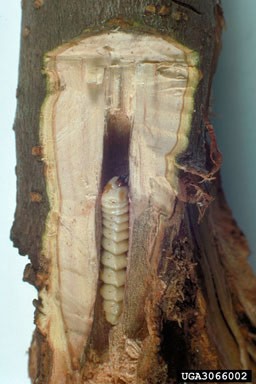I spent part of yesterday on my belly at the base of a tree with a knife and a length of wire in my hand. I was trying to kill something.
The tree was an apple, a Cox’s Orange Pippin to be exact, and what I was trying to kill was the roundheaded appletree borer, which was doing its best to kill the tree. I knew it was there because I could see the orange, sawdust-like frass at the base of the tree, which showed that the larva was munching away.
In June and July, this insect lays eggs beneath the bark at the base of a tree. When the larvae hatch in two or three weeks, they start eating wood beneath the bark, tunneling up a few inches. They’ll stay in the tree up to three years, and their tunnels diminish the tree’s capacity for nutrient flow and compromise its structural integrity. I’d lost four planted apple trees to the borer 20 years ago when we planted them in the side yard the year we built our house. I don’t want to go through that again. First, the tree started to lose its leaves early. The next spring its foliage was sparse, and the third year, it didn’t leaf out. When I went to remove it, it broke off at its base, a sure sign that it was the work of the borer.
I’ve been to workshops for apple growers, and many of them have not been plagued by the borer. Lucky them. We have hundreds of wild apple trees on our land, most of them concentrated in an old pasture. Through the WHIP program, which pays cost-share funds to landowners to release and prune wild apple trees to benefit wildlife, I have freed 105 trees from competing trees. Some of the removed trees were softwoods, some cherries and soft maples, but many of them were fellow apples. In those cases, I had to choose which one to keep, based on form, fruit, and a little intuition.
Cutting the competing apples made it abundantly clear to me how extensive our borer problem is because nearly every one of the trees I cut showed tunnels in their stumps. The good news was that the wild trees had succeeded in growing more wood around the tunnels and had attained sufficient diameter to overcome the borer’s wounds.
It’s the newly planted stock that is most vulnerable, because the tunnels can constitute a large enough proportion of the trunk that it will snap off at ground level. Go take a look at your young apple trees now. Bring along a knife and a length of wire and be ready to put them to use if you notice orange frass at the base of a tree. Follow the tunnels with the wire and see if you can impale the larva. It’s a cream-colored legless grub that will grow from 1/8 inch on hatching to longer than an inch as it develops. Be willing to cut away the compromised bark that covers the tunnels. Keep looking. Kill the bug. Your tree’s existence depends on you.
For more on the roundheaded appletree borer, go to Cornell’s Integrated Pest Management website. Or read The Apple Grower: A Guide for the Organic Orchardist by Michael Phillips.



Discussion *